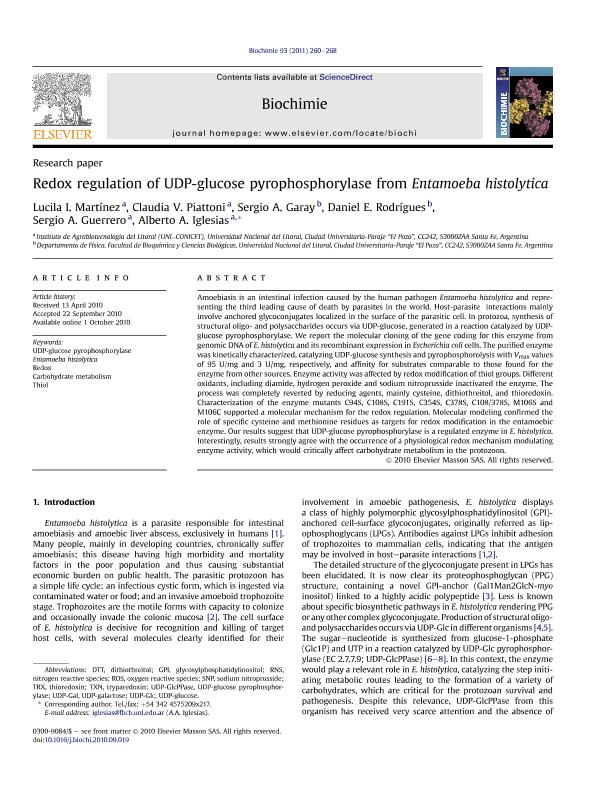Mostrar el registro sencillo del ítem
dc.contributor.author
Martínez, Lucila Inés

dc.contributor.author
Piattoni, Claudia Vanesa

dc.contributor.author
Garay, Alberto
dc.contributor.author
Rodrigues, Daniel Enrique

dc.contributor.author
Guerrero, Sergio Adrian

dc.contributor.author
Iglesias, Alberto Alvaro

dc.date.available
2017-03-06T17:44:42Z
dc.date.issued
2011-02
dc.identifier.citation
Martínez, Lucila Inés; Piattoni, Claudia Vanesa; Garay, Alberto; Rodrigues, Daniel Enrique; Guerrero, Sergio Adrian; et al.; Redox Regulation of UDP-glucose Pyrophosphorylase from Entamoeba histolytica; Elsevier France-editions Scientifiques Medicales Elsevier; Biochimie; 93; 2; 2-2011; 260-268
dc.identifier.issn
0300-9084
dc.identifier.uri
http://hdl.handle.net/11336/13555
dc.description.abstract
Amoebiasis is an intestinal infection caused by the human pathogen Entamoeba histolytica and representing the third leading cause of death by parasites in the world. Host-parasite interactions mainly involve anchored glycoconjugates localized in the surface of the parasitic cell. In protozoa, synthesis of structural oligo- and polysaccharides occurs via UDP-glucose, generated in a reaction catalyzed by UDP-glucose pyrophosphorylase. We report the molecular cloning of the gene coding for this enzyme from genomic DNA of E. histolytica and its recombinant expression in Escherichia coli cells. The purified enzyme was kinetically characterized, catalyzing UDP-glucose synthesis and pyrophosphorolysis with V(max) values of 95 U/mg and 3 U/mg, respectively, and affinity for substrates comparable to those found for the enzyme from other sources. Enzyme activity was affected by redox modification of thiol groups. Different oxidants, including diamide, hydrogen peroxide and sodium nitroprusside inactivated the enzyme. The process was completely reverted by reducing agents, mainly cysteine, dithiothreitol, and thioredoxin. Characterization of the enzyme mutants C94S, C108S, C191S, C354S, C378S, C108/378S, M106S and M106C supported a molecular mechanism for the redox regulation. Molecular modeling confirmed the role of specific cysteine and methionine residues as targets for redox modification in the entamoebic enzyme. Our results suggest that UDP-glucose pyrophosphorylase is a regulated enzyme in E. histolytica. Interestingly, results strongly agree with the occurrence of a physiological redox mechanism modulating enzyme activity, which would critically affect carbohydrate metabolism in the protozoon.
dc.format
application/pdf
dc.language.iso
eng
dc.publisher
Elsevier France-editions Scientifiques Medicales Elsevier

dc.rights
info:eu-repo/semantics/openAccess
dc.rights.uri
https://creativecommons.org/licenses/by-nc-nd/2.5/ar/
dc.subject
Udp-Glucose Pyrophosphorylase
dc.subject
Entamoeba Histolytica
dc.subject
Redox
dc.subject
Carbohydrate Metabolism
dc.subject.classification
Bioquímica y Biología Molecular

dc.subject.classification
Ciencias Biológicas

dc.subject.classification
CIENCIAS NATURALES Y EXACTAS

dc.title
Redox Regulation of UDP-glucose Pyrophosphorylase from Entamoeba histolytica
dc.type
info:eu-repo/semantics/article
dc.type
info:ar-repo/semantics/artículo
dc.type
info:eu-repo/semantics/publishedVersion
dc.date.updated
2017-03-01T17:49:53Z
dc.journal.volume
93
dc.journal.number
2
dc.journal.pagination
260-268
dc.journal.pais
Francia

dc.journal.ciudad
París
dc.description.fil
Fil: Martínez, Lucila Inés. Consejo Nacional de Investigaciones Científicas y Técnicas. Centro Científico Tecnológico Santa Fe. Instituto de Desarrollo Tecnológico para la Industria Química (i); Argentina
dc.description.fil
Fil: Piattoni, Claudia Vanesa. Consejo Nacional de Investigaciones Científicas y Técnicas. Centro Científico Tecnológico Santa Fe. Instituto de Desarrollo Tecnológico para la Industria Química (i); Argentina
dc.description.fil
Fil: Garay, Alberto. Universidad Nacional del Litoral. Facultad de Bioquímica y Ciencias Biológicas. Departamento de Física; Argentina
dc.description.fil
Fil: Rodrigues, Daniel Enrique. Consejo Nacional de Investigaciones Científicas y Técnicas. Centro Científico Tecnológico Santa Fe. Instituto de Desarrollo Tecnológico para la Industria Química (i); Argentina. Universidad Nacional del Litoral. Facultad de Bioquímica y Ciencias Biológicas; Argentina
dc.description.fil
Fil: Guerrero, Sergio Adrian. Consejo Nacional de Investigaciones Científicas y Técnicas. Centro Científico Tecnológico Santa Fe. Instituto de Desarrollo Tecnológico para la Industria Química (i); Argentina
dc.description.fil
Fil: Iglesias, Alberto Alvaro. Consejo Nacional de Investigaciones Científicas y Técnicas. Centro Científico Tecnológico Santa Fe. Instituto de Desarrollo Tecnológico para la Industria Química (i); Argentina
dc.journal.title
Biochimie

dc.relation.alternativeid
info:eu-repo/semantics/altIdentifier/doi/http://dx.doi.org/10.1016/j.biochi.2010.09.019
dc.relation.alternativeid
info:eu-repo/semantics/altIdentifier/url/https://www.sciencedirect.com/science/article/pii/S0300908410003354
Archivos asociados
